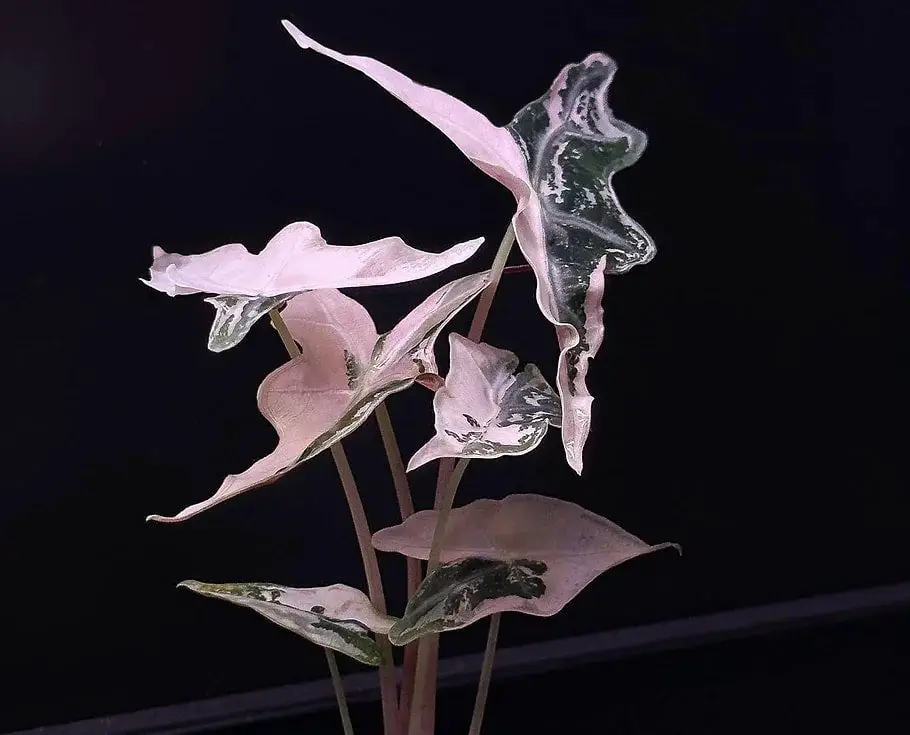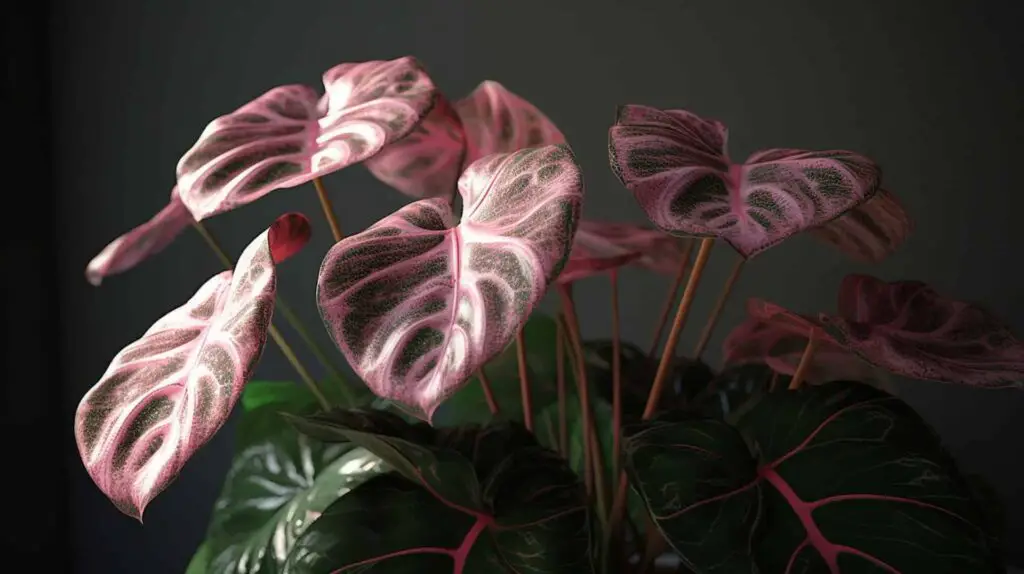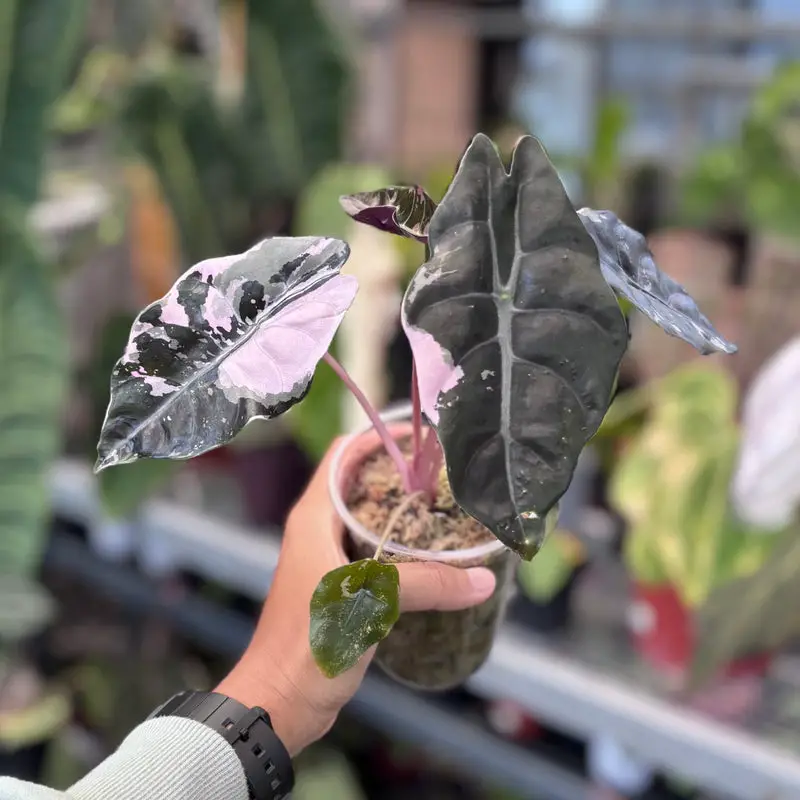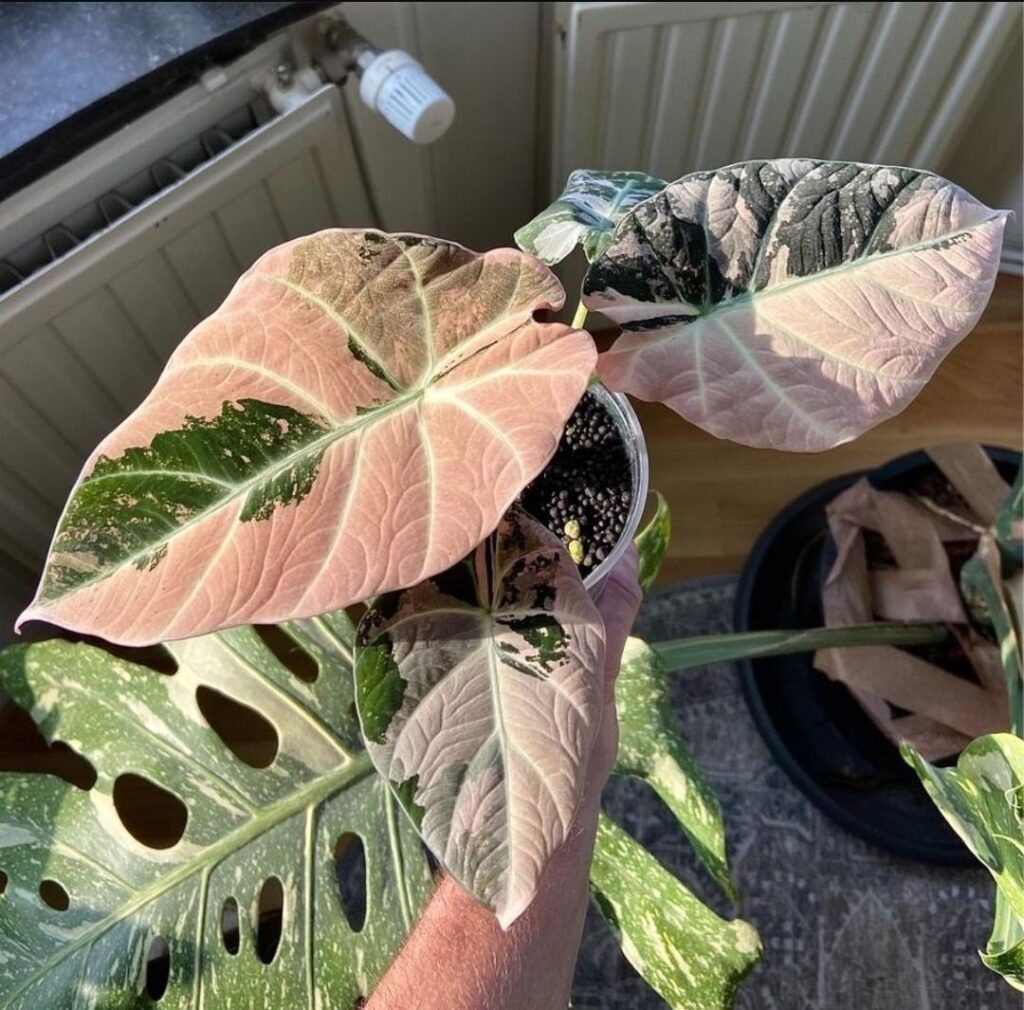Black Velvet Pink Alocasia Variegation is a stunning tropical plant known for its dark green leaves adorned with pink or white veins. This unique appearance makes it highly sought after by plant enthusiasts and collectors.
Understanding Black Velvet Alocasia
The Black Velvet Alocasia, scientifically known as Alocasia reginula, is a member of the Araceae family. This plant is native to Southeast Asia, particularly found in the rainforests of Borneo and Sumatra. Its characteristic dark, velvety leaves create an appealing contrast against its vibrant pink or white veins, giving it a distinctive and elegant look.

Over the years, the popularity of Black Velvet Alocasia has surged among indoor gardeners. Its striking appearance and relatively manageable care requirements make it perfect for both beginners and experienced plant owners. However, its variegated forms, particularly the ones showcasing pink veins, are rarer and more coveted.
Characteristics of Black Velvet Pink Alocasia
The Black Velvet Pink Alocasia possesses several features that set it apart from other houseplants. Here are some key characteristics:
- Leaf Texture: The leaves are thick and have a soft, velvety texture.
- Coloration: The deep green color of the leaves contrasts beautifully with the vibrant pink or white veins.
- Growth Habit: It typically grows upright with a compact form, making it suitable for various indoor settings.
- Height: The plant can reach heights of about 12 to 24 inches when fully mature.
Cultivation and Care
Caring for Black Velvet Pink Alocasia requires attention to a few specific needs. Proper care will ensure that the plant thrives and displays its beautiful variegation. Below are essential care tips:

- Light: Place the plant in bright, indirect light. Too much direct sunlight can scorch the leaves.
- Water: Keep the soil consistently moist but not soggy. Water when the top inch of soil feels dry.
- Humidity: This plant thrives in high humidity. Consider using a humidifier or placing a tray of water near the plant.
- Soil: Use well-draining potting soil to prevent root rot.
- Fertilization: Fertilize every 4 to 6 weeks during the growing season with a balanced liquid fertilizer.
Variegation in Black Velvet Pink Alocasia
The variegation of the Black Velvet Pink Alocasia is due to a genetic mutation that affects chlorophyll production in certain areas of the leaves. This results in striking patches of color that enhance its visual appeal. Variegated plants are often more sought after because they are considered rarer than their solid-colored counterparts.
The pink variegation in particular can vary in intensity. Some leaves may show bright pink veins, while others may have a more muted tone. The amount of variegation can change depending on growing conditions, light exposure, and overall plant health.
Table of Variegation Characteristics
| Variegation Type | Description | Rarity Level |
|---|---|---|
| Pink Veins | Vibrant pink veins against dark green leaves | Rare |
| White Veins | White veins contrasting with the green surface | Less common |
The appreciation for variegated plants continues to grow. Thus, understanding their care and characteristics is crucial for those looking to add them to their collection. Black Velvet Pink Alocasia not only brings beauty to your space but can also be a rewarding gardening experience.

Propagation Methods for Black Velvet Pink Alocasia
Propagating Black Velvet Pink Alocasia can be an exciting venture for plant enthusiasts. It allows you to multiply your collection or share this unique plant with friends. There are several effective methods for propagation, each with its own steps and considerations.
Division Method
One of the most common methods is division. This technique involves separating the plant into multiple sections, each containing roots and stems. Here are the steps to propagate using the division method:
- Choose the Right Time: The best time for division is during the growing season, typically in spring or early summer.
- Prepare Tools: Gather clean, sharp tools such as a knife or spade. Sterilizing your tools can prevent infections.
- Remove the Plant: Gently take the plant out of its pot, taking care not to damage the roots.
- Divide the Plant: Carefully separate the root ball into smaller sections, ensuring each section has at least one stem and a good amount of roots.
- Repot Sections: Place each new section in its own pot with fresh, well-draining soil. Water them lightly after potting.
Offsets Method
Another effective propagation method involves using offsets, which are small plantlets that grow around the base of the main plant. Here’s how to propagate using offsets:
- Identify Offsets: Look for offsets that have developed around the base of the parent plant.
- Gently Remove Offsets: Use a clean knife to cut the offset away from the main plant, ensuring it has some roots attached.
- Potting: Plant the offset in a small pot with suitable soil. Keep it moist but not soggy.
Pests and Diseases
Like all houseplants, Black Velvet Pink Alocasia is susceptible to certain pests and diseases. Awareness of these potential issues can help you maintain a healthy plant.

Common Pests
- Spider Mites: These tiny pests thrive in dry conditions and can cause leaf discoloration and webbing. Increasing humidity can help deter them.
- Aphids: These small insects feed on sap and can lead to yellowing leaves. Using insecticidal soap can effectively manage an infestation.
- Mealybugs: They appear as white, cotton-like masses on the plant. Removing them manually or using a cotton swab dipped in alcohol can help eliminate them.
Disease Concerns
The most common disease affecting Black Velvet Pink Alocasia is root rot, which occurs due to overwatering and poor drainage. If left untreated, it can lead to serious damage or death of the plant. To minimize risks:
- Avoid Overwatering: Ensure soil dries out between waterings.
- Use Well-Draining Soil: This helps prevent water from sitting at the roots.
- Inspect Regularly: Check for signs of rot, such as mushy roots or a foul smell.
Environmental Conditions
The environment where you place your Black Velvet Pink Alocasia plays a crucial role in its growth and health. Here are key environmental factors to consider:
Light Requirements
This plant prefers bright, indirect light. Too little light can lead to slow growth and diminished variegation, while too much direct sunlight can scorch its leaves. A south or east-facing window is often ideal.
Humidity Levels
As a tropical plant, Black Velvet Pink Alocasia thrives in high humidity environments. Ideally, humidity levels should be between 60% to 80%. You can increase humidity by:
- Using a humidifier in the room.
- Grouping plants together to create a microclimate.
- Placing a pebble tray filled with water beneath the pot.
Temperature Preferences
This Alocasia variety prefers temperatures between 65°F to 80°F (18°C to 27°C). Avoid exposing the plant to cold drafts or sudden temperature changes, as this can stress the plant and hinder its growth.
B
y understanding propagation methods, pest management, and environmental needs, you can successfully cultivate Black Velvet Pink Alocasia while enjoying its beauty and uniqueness in your home.
Common Myths about Black Velvet Pink Alocasia
As with many popular houseplants, several myths surround the Black Velvet Pink Alocasia. Understanding these misconceptions can help potential owners make informed decisions and care for their plants correctly.
Myth 1: Black Velvet Alocasia is High Maintenance
Many believe that because of its exotic appearance, the Black Velvet Pink Alocasia requires extensive care and attention. In reality, while it does need specific conditions, it is not overly difficult to maintain. With the right light, humidity, and water schedule, it can thrive in most indoor environments.
Myth 2: Variegated Plants are Always More Expensive
While it’s true that variegated plants, including the Black Velvet Pink Alocasia, are often more sought after, their prices can vary. Factors such as availability and market demand influence cost. It is possible to find reasonably priced specimens if you shop around or look for reputable sellers.
Myth 3: All Alocasia Plants are Poisonous
While it is correct that many Alocasia species contain calcium oxalate crystals, which can be toxic if ingested, not all varieties pose the same level of risk. The Black Velvet Pink Alocasia should be kept out of reach of pets and children, but with proper care and handling, it can be a safe addition to your home.
Fertilizing Black Velvet Pink Alocasia
Proper fertilization is crucial for the growth and health of the Black Velvet Pink Alocasia. Providing nutrients helps the plant maintain its vibrant coloration and overall vitality. Here are some guidelines for fertilizing:
Types of Fertilizers
- Liquid Fertilizers: These are easy to apply and can be mixed with water for a diluted solution. They are ideal for regular feeding during the growing season.
- Slow-Release Fertilizers: These pellets release nutrients gradually over time. They are beneficial for providing sustained nutrition without frequent applications.
Fertilization Schedule
The best time to fertilize your Black Velvet Pink Alocasia is during its active growing season, typically from spring to early fall. Here’s a suggested schedule:
- Spring: Start fertilizing every 4-6 weeks as new growth begins.
- Summer: Continue with the same frequency. Monitor the plant’s health; if it appears to be growing vigorously, you may increase the frequency slightly.
- Fall: Gradually reduce fertilization as growth slows down.
- Winter: Avoid fertilizing during dormancy unless you notice signs of new growth.
Common Problems and Solutions
Even with proper care, Black Velvet Pink Alocasia may encounter issues. Recognizing these problems early can help you take action before they worsen.
Yellowing Leaves
Yellowing leaves can indicate several issues:
- Overwatering: This is the most common cause. Ensure you are allowing the top inch of soil to dry out between waterings.
- Pest Infestation: Check for pests such as spider mites or aphids. Treat affected areas with insecticidal soap or neem oil.
- Nutrient Deficiency: If yellowing occurs despite proper watering, consider adjusting your fertilization routine.
Browning Leaf Edges
Browning edges can result from low humidity or underwatering. To remedy this issue:
- Increase Humidity: Use a humidifier or mist the plant regularly.
- Water Consistently: Ensure you are providing adequate moisture without overwatering.
Leaf Drop
If your Black Velvet Pink Alocasia is dropping leaves, it may be experiencing stress from environmental changes. Common causes include:
- Sudden Temperature Changes: Keep the plant away from drafts and heating vents.
- Transplant Shock: If you recently repotted, it may take time for the plant to adjust.
Displaying Your Black Velvet Pink Alocasia
The
unique beauty of the Black Velvet Pink Alocasia makes it an excellent decorative piece in any home. Here are some tips for displaying this stunning plant:
Pot Selection
Select a pot that complements the plant’s dark foliage while providing adequate drainage. Consider using decorative pots that enhance its aesthetic appeal without overwhelming its beauty.
Placement Ideas
- Living Room: Place it near a window where it can receive bright, indirect light.
- Office Space: Add a touch of greenery to your workspace by placing it on a desk or shelf.
- Bathroom: If your bathroom has sufficient light and humidity, the Black Velvet Pink Alocasia can thrive there.
By addressing common myths, proper fertilization methods, and potential issues, you can enjoy a healthy and visually striking Black Velvet Pink Alocasia in your home.
Additional Care Tips for Black Velvet Pink Alocasia
To keep your Black Velvet Pink Alocasia thriving, consider these additional care tips that can enhance its growth and overall health.
Water Quality
The quality of water you use for your plant can significantly impact its health. Here are a few points to consider:
- Use Filtered Water: Tap water may contain chemicals like chlorine and fluoride, which can harm sensitive plants. Using filtered or distilled water is often a better option.
- Room Temperature: Watering with room temperature water can prevent shocking the plant’s roots. Cold water can impede its growth.
Seasonal Care Adjustments
As seasons change, so do the care needs of your Black Velvet Pink Alocasia. Adjust your care routine accordingly:
- Spring and Summer: Focus on maintaining higher humidity levels and regular feeding as the plant grows actively.
- Fall: Gradually decrease watering and fertilization as the plant enters dormancy.
- Winter: Limit water and stop fertilizing to allow the plant to rest. Keep it in a warm spot away from drafts.
Pruning and Maintenance
Regular maintenance can keep your plant looking its best. Here are some tips for pruning:
- Remove Dead Leaves: Trim off yellow or dead leaves to promote healthy growth and improve the plant’s appearance.
- Check for Pests: Regularly inspect the undersides of leaves for pests during your maintenance routine.
Community and Support for Plant Enthusiasts
Joinin
g a community of plant lovers can enrich your experience with Black Velvet Pink Alocasia. Here are ways to connect:
- Online Forums: Participate in gardening forums and social media groups dedicated to houseplants. You can share experiences, tips, and advice.
- Local Plant Clubs: Look for local gardening clubs where you can meet fellow plant enthusiasts and exchange plants or cuttings.
- Workshops and Events: Attend workshops or plant shows to learn more about caring for tropical plants and expanding your knowledge.
Final Thoughts
The Black Velvet Pink Alocasia is a remarkable plant that adds elegance and beauty to any space. Its unique variegation, combined with its manageable care requirements, makes it an excellent choice for both novice and experienced gardeners. Understanding its needs in terms of light, humidity, water quality, and seasonal adjustments allows for optimal growth and health.
Whether you’re propagating new plants, managing pests, or displaying it as a stunning focal point in your home, the Black Velvet Pink Alocasia offers a rewarding experience. By engaging with fellow plant enthusiasts and continuously learning about this captivating species, you can ensure your plant remains a vibrant part of your collection for years to come.
Embrace the journey of nurturing your Black Velvet Pink Alocasia. With proper care and attention, you will enjoy the beauty of this exotic plant as it flourishes in your home.
